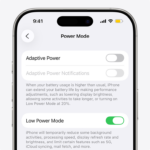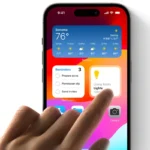When it comes to staying current with software updates, not all iPhones make the cut. Apple is known for providing iOS updates to its devices for several years post-release. However, there eventually comes a time when older models no longer receive the latest software support. This is a key factor for users who value both the new features that updates bring and the continued security they provide. Keeping an eye on which models still receive updates can help users make informed decisions about when to upgrade their devices.
Understanding which iPhones still qualify for the latest iOS updates is straightforward. Generally, Apple supports its iPhone models with new software updates for about five to six years. After this period, older devices may not run the latest software efficiently due to hardware limitations, which can lead to their exclusion from receiving new updates. As a result, the list of supported devices changes with the introduction of each new iOS version, moving older models toward obsolescence and encouraging users to consider newer models.
1. iPhones That Support iOS 26 (Full Updates)
According to Apple’s official iOS 26 compatibility list, the following models can install iOS 26, meaning they receive full feature and security updates:
- iPhone 17 / 17 Plus / 17 Pro / 17 Pro Max
- iPhone 16 / 16 Plus / 16 Pro / 16 Pro Max / 16e
- iPhone 15 / 15 Plus / 15 Pro / 15 Pro Max
- iPhone 14 / 14 Plus / 14 Pro / 14 Pro Max
- iPhone 13 / 13 mini / 13 Pro / 13 Pro Max
- iPhone 12 / 12 mini / 12 Pro / 12 Pro Max
- iPhone 11 / 11 Pro / 11 Pro Max
- iPhone SE (3rd generation, 2nd Generation)
👉 Oldest fully supported iPhone: iPhone 11 (2019)
This makes the iPhone 11 series the oldest models still receiving major iOS updates (iOS 26).
2. iPhones That Still Get Security Updates (iOS 18.x)
Apple continues to provide security-only updates for older devices that can’t run iOS 26.
As of late 2025, iOS 18.x is still maintained for:
- iPhone 16 / 16 Plus / 16 Pro / 16 Pro Max / 16e
- iPhone 15 / 15 Plus / 15 Pro / 15 Pro Max
- iPhone 14 / 14 Plus / 14 Pro / 14 Pro Max
- iPhone 13 / 13 mini / 13 Pro / 13 Pro Max
- iPhone 12 / 12 mini / 12 Pro / 12 Pro Max
- iPhone 11 / 11 Pro / 11 Pro Max
- iPhone XS / XS Max / XR
- iPhone SE (3rd Generation, 2nd generation)
These devices no longer receive new features but continue to get critical security patches — similar to how Apple supported iOS 15 and iOS 16 after major version transitions.
👉 Oldest iPhone still receiving security updates: iPhone XR (2018)
3. No Longer Supported
The following iPhones are now fully unsupported (no iOS or security updates as of 2025):
- iPhone X (2017)
- iPhone 8 / 8 Plus (2017)
- iPhone SE (1st generation, 2016)
- Any earlier models
These devices may still function but are no longer recommended for security reasons.
✅ Summary
| Category | iOS Version | Oldest Supported Model | Year Released |
|---|---|---|---|
| Full iOS Updates | iOS 26 | iPhone 11 | 2020 |
| Security Updates Only | iOS 18.x | iPhone XR | 2018 |
| No Updates | — | iPhone X and earlier | 2017 or older |
💡 Tip
If you’re buying a used iPhone in 2025, aim for iPhone 13 or newer to ensure at least 3–4 more years of full iOS support.
Key Takeaways
- Newer iPhone models receive iOS updates for about five to six years after their release.
- Apple’s hardware support determines an iPhone’s eligibility for the latest software updates.
- Knowing the update status of iPhone models is essential for maintaining device security and functionality.
Understanding iPhone Software and Hardware Support
Apple provides continuous software and hardware support for its iPhone models, ensuring longevity and security through ongoing iOS updates and repair services.
Evolution of iPhone Models
The iPhone has gone through many changes since the original release. New models improve on hardware and software. Apple has released models from the iPhone 5 to the iPhone 15.
iOS Update Mechanism
Apple sends iOS updates to iPhones for up to seven years after the last sale of a model. These updates include new features, security patches, and bug fixes. This keeps the operating system running smoothly and securely.
Factors Influencing iPhone Updates
Several factors affect updates for an iPhone model. These include the device’s hardware capabilities, performance needs, and battery life. Apple considers these factors to ensure updates enhance the iPhone experience without causing issues.
The Role of Apple Support
Apple Support provides hardware services for iPhone models. These services are available for about five to seven years after a product is no longer sold. Users visit Apple stores for support and repairs.
Apple’s Commitment to Security
Security is key in Apple’s support strategy. Software support from Apple includes regular updates that fix any bugs and security flaws. This minimizes risks to users and their data.
Assessing the Update Status of Older iPhone Models
With each software release, Apple extends OS update support for some iPhones while older models may fall off the list. This section explores which models still receive updates, identifies the oldest iPhones eligible, and considers how hardware limits impact software support.
Update Eligibility for Older iPhones
To find out if an older iPhone model qualifies for the latest OS update, Apple’s support page or announcements are the primary sources. Typically, Apple sustains software support for iPhone models several years post-release. For example, the iPhone 6S and the first generation iPhone SE, both released back in 2015 and 2016, respectively, were among the oldest models to receive the iOS 14 update in 2020.
Determining the Oldest Supported iPhone
As of the last official announcement, the oldest iPhone models still receiving updates from Apple include the iPhone 6s and iPhone SE (1st generation). Users can confirm the status of their device by checking the latest iOS version compatibility or reviewing Apple’s documentation on supported devices.
Impact of Hardware Limitations
Hardware constraints are often a cause for an iPhone’s loss of update support. As software advances, it requires more powerful processing capabilities and memory, which older models like the iPhone 5 or iPhone 5s may lack. These hardware limitations can affect app performance and the user experience, leading to discontinued software support to maintain a standard of functionality and security.







